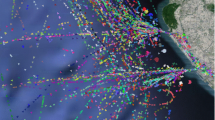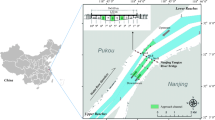Abstract
The growing volume of maritime traffic is proving a hindrance to navigational safety. Researchers have sought to improve the safety of maritime transportation by conducting statistical analysis on historical collision data in order to identify the causes of maritime collisions. However, this approach is hindered by the limited number of incidents that can be collected in a given area over a given period of time. Automatic Identification System (AIS) has made available enormous quantities of maritime traffic data. Trajectory data are collected through the electronic exchange of navigational data among ships and terrestrial and satellite base stations. Due to a massive AIS data of recording ship movement, such data provide great opportunity to discover maritime traffic knowledge of movement behavior analysis, route estimation, and the detection of anomalous behaviors. Our objective in this paper was to identify potential between-ship traffic conflicts through the discovery of AIS data. Traffic conflict refers to trajectories that could lead to a collision if the ships do not take any evasive action. In other words, conflicting trajectories can be treated as a near-collision cases for analysis. The prevention of collisions requires an efficient method by which to extract conflicting trajectories from a massive collection of AIS data. To this end, we developed a framework CCT Discovery that allows the automated identification of clusters of conflicting trajectories (CCTs) from AIS data without supervision. Experiments based on real-world data demonstrate the efficacy of the proposed framework in terms of accuracy and efficiency. For improvement in the navigational traffic safety, the discovered data of conflict trajectory can contribute to numerous applications, such as collision situation awareness and prediction, anti-collision behaviors modeling and recommendation, and conflict area analysis for maritime traffic flow management.





























Similar content being viewed by others
References
AlRajie H, Ismail K (2016) Investigation of using microscopic traffic simulation tools to predict cyclist-vehicle-traffic conflicts at signalized intersections. In: Transportation research board 95th annual meeting, No. 16-4383
Arguedas VF, Pallotta G, Vespe M (2014) Automatic generation of geographical networks for maritime traffic surveillance. In: Proceedings of 17th international conference on information fusion (FUSION), pp. 1–8
Cazzanti L, Millefiori LM, Arcieri G (2015) A document-based data model for large scale computational maritime situational awareness. In: Proceedings of 2015 IEEE international conference on big data, pp 1350–1356
Chen Z, Shen HT, Zhou X (2011) Discovering popular routes from trajectories. In: Proceedings of 2011 IEEE 27th international conference on data engineering, pp 900–911
Chin HC, Quek ST (1997) Measurement of traffic conflicts. Saf Sci 26(3):169–185
Debnath A, Chin H, Haque M (2011) Modelling port water collision risk using traffic conflicts. J Navig 64(1):645–655
Debnath AK, Chin HC (2006) Analysis of marine conflicts. In: Proceedings of the 19th KKCNN symposium on civil engineering
Debnath AK, Chin HC (2010) Navigational traffic conflict technique: a proactive approach to quantitative measurement of collision risks in port waters. J Navig 63(1):137–152
El-Basyouny K, Sayed T (2013) Safety performance functions using traffic conflicts. Saf Sci 51(1):160–164
Gettman D, Head L (2003) Surrogate safety measures from traffic simulation models. Transp Res Rec J Transp Res Board 1840:104–115
Giannotti F, Nanni M, Pedreschi D (2006) Efficient mining of temporally annotated sequences. In: Proceedings of the 2006 SIAM international conference on data mining, pp 348–359
Giannotti F, Nanni M, Pinelli F, Pedreschi D (2007) Trajectory pattern mining. In: Proceedings of the 13th ACM SIGKDD international conference on knowledge discovery and data mining, pp 330–339
Guyet T, Quiniou R (2008) Mining temporal patterns with quantitative intervals. In: Proceedings of 2008 IEEE international conference on data mining workshops, pp 218–227
Huang F, Liu P, Yu H, Wang W (2013) Identifying if vissim simulation model and ssam provide reasonable estimates for field measured traffic conflicts at signalized intersections. Accid Anal Prev 50:1014–1024
Hung CC, Peng WC, Lee WC (2015) Clustering and aggregating clues of trajectories for mining trajectory patterns and routes. VLDB J Int J Very Large Data Bases 24(2):169–192
Jeung H, Liu Q, Shen HT, Zhou X (2008) A hybrid prediction model for moving objects. In: Proceedings of 2008 IEEE 24th international conference on data engineering, pp 70–79
Jeung H, Shen HT, Zhou X (2008) Convoy queries in spatio-temporal databases. In: Proceedings of 2008 IEEE 24th International Conference on Data Engineering, pp 1457–1459
Kalnis P, Mamoulis N, Bakiras S (2005) On discovering moving clusters in spatio-temporal data. In: International symposium on spatial and temporal databases. Springer, pp 364–381
Lai Z, Karim I, Xianghai M (2014) Traffic conflict techniques for road safety analysis: open questions and some insights. Can J Civ Eng 41(7):633–641
Lee JG, Han J, Li X, Gonzalez H (2008) Traclass: trajectory classification using hierarchical region-based and trajectory-based clustering. Proc VLDB Endow 1(1):1081–1094
Lee JG, Han J, Whang KY (2007) Trajectory clustering: a partition-and-group framework. In: Proceedings of the 2007 ACM SIGMOD international conference on management of data, pp 593–604
Lei P (2016) A framework for anomaly detection in maritime trajectory behavior. Knowl Inf Syst 47(1):189–214
Lei P, Tsai T, Wen YT, Peng W (2017) A framework for discovering maritime traffic conflict from AIS network. In: 19th Asia-Pacific network operations and management symposium, APNOMS 2017, Seoul, Korea (South), September 27–29, 2017, pp 1–6
Lei PR, Li SC, Peng WC (2013) Qs-stt: Quadsection clustering and spatial-temporal trajectory model for location prediction. Distrib Parallel Databases 31(2):231–258
Li Q, Fan HSL (2012) A simulation model for detecting vessel conflicts within a seaport. Int J Mar Navig Saf Sea Transp 6(1):11–17
Li Z, Ding B, Han J, Kays R (2010) Swarm: mining relaxed temporal moving object clusters. Proc VLDB Endow 3(1–2):723–734
Lu CT, Lei PR, Peng WC, Su J (2011) A framework of mining semantic regions from trajectories. In: Proceedings of international conference on database systems for advanced applications, pp 193–207
Mazzarella F, Arguedas VF, Vespe M (2015) Knowledge-based vessel position prediction using historical AIS data. In: IEEE workshop 2015 sensor data fusion: trends, solutions, applications (SDF), pp 1–6
Monreale A, Pinelli F, Trasarti R, Giannotti F (2009) Wherenext: a location predictor on trajectory pattern mining. In: Proceedings of the 15th ACM SIGKDD international conference on knowledge discovery and data mining, pp 637–646
Pallotta G, Vespe M, Bryan K (2013) Vessel pattern knowledge discovery from AIS data: a framework for anomaly detection and route prediction. Entropy 15(6):2218–2245
Perkins SR, Harris JL (1968) Traffic conflict characteristics-accident potential at intersections. Highw Res Rec 225:35–43
Petelin B, Kononenko I, Malačič V, Kukar M (2013) Multi-level association rules and directed graphs for spatial data analysis. Expert Syst Appl 40(12):4957–4970
Petelin B, Kononenko I, Malačič V, Kukar M (2015) Dynamic fuzzy paths and cycles in multi-level directed graphs. Eng Appl Artif Intell 37:194–206
Petzoldt T, Schleinitz K, Heilmann S, Gehlert T (2017) Traffic conflicts and their contextual factors when riding conventional versus electric bicycles. Transp Res Part F Traffic Psychol Behav 46:477–490
Sang Lz, Yan Xp, Wall A, Wang J, Mao Z (2016) Cpa calculation method based on AIS position prediction. J Navig 69(6):1409–1426
Santos MY, Silva JP, Moura-Pires J, Wachowicz M (2012) Automated traffic route identification through the shared nearest neighbour algorithm. In: Bridging the geographic information sciences. Springer, pp 231–248
Sayed T, Zaki MH, Autey J (2013) Automated safety diagnosis of vehicle-bicycle interactions using computer vision analysis. Saf Sci 59:163–172
Sayed T, Zein S (1999) Traffic conflict standards for intersections. Transp Plan Technol 22(4):309–323
Shahdah U, Saccomanno F, Persaud B (2014) Integrated traffic conflict model for estimating crash modification factors. Accid Anal Prev 71:228–235
Shie BE, Hsiao HF, Tseng V (2013) Efficient algorithms for discovering high utility user behavior patterns in mobile commerce environments. Knowl Inf Syst 37(2):363–387
Silveira P, Teixeira A, Soares CG (2013) Use of ais data to characterise marine traffic patterns and ship collision risk off the coast of portugal. J Navig 66(6):879
Sormunen OVE, Goerlandt F, Häkkinen J, Posti A, Hänninen M, Montewka J, Ståhlberg K, Kujala P (2014) Uncertainty in maritime risk analysis: extended case study on chemical tanker collisions. J Eng Marit Environ 124:142–157
Tan PN, Steinbach M, Kumar V (2013) Cluster analysis: basic concepts and algorithms. In: Introduction to data mining, pp 487–559
Vespe M, Pallottaand G, Visentini I, Bryan K, Braca P (2012) Maritime trajectory mining for anomaly detection. In: Symposium on port and regional maritime security 2012
Wei LY, Peng WC, Lee WC (2013) Exploring pattern-aware travel routes for trajectory search. ACM Trans Intell Syst Technol (TIST) 4(3):48
Wei LY, Zheng Y, Peng WC (2012) Constructing popular routes from uncertain trajectories. In: Proc. the 18th ACM SIGKDD international conference on knowledge discovery and data mining (KDD), pp 195–203
Weng J, Meng Q, Qu X (2012) Vessel collision frequency estimation in the singapore strait. J Navig 65(2):207–221
Wu G, Ding Y, Li Y, Bao J, Zheng Y, Luo J (2017) Mining spatio-temporal reachable regions over massive trajectory data. In: Proceedings of 2017 IEEE 33rd international conference on data engineering (ICDE), pp 1283–1294
Xue AY, Zhang R, Zheng Y, Xie X, Huang J, Xu Z (2013) Destination prediction by sub-trajectory synthesis and privacy protection against such prediction. In: Proceedings of 2013 IEEE 29th international conference on data engineering (ICDE), pp 254–265
Yan W, Wen R, Zhang AN, Yang D (2016) Vessel movement analysis and pattern discovery using density-based clustering approach. In: Proceedings of 2016 IEEE international conference on big data (Big Data), pp 3798–3806
Zhang W, Goerlandt F, Montewka J, Kujala P (2015) A method for detecting possible near miss ship collisions from ais data. Ocean Eng 107:60–69
Zheng K, Zheng Y, Yuan NJ, Shang S (2013) On discovery of gathering patterns from trajectories. In: Proceedings of 2013 IEEE 29th international conference on data engineering (ICDE), pp 242–253
Zheng VW, Zheng Y, Xie X, Yang Q (2010) Collaborative location and activity recommendations with gps history data. In: Proceedings of the 19th international conference on world wide web, pp 1029–1038
Zheng Y (2015) Trajectory data mining: an overview. ACM Trans Intell Syst Technol (TIST) 6(3):29
Zheng Y, Xie X (2011) Learning travel recommendations from user-generated gps traces. Intell Syst Technol 2(1):1–29
Zhou H, Hirasawa K (2018) Spatiotemporal traffic network analysis: technology and applications. In: Knowledge and information systems, pp 1–37
Zhu WY, Peng WC, Hung CC, Lei PR, Chen LJ (2014) Exploring sequential probability tree for movement-based community discovery. IEEE Trans Knowl Data Eng 26(11):2717–2730
Acknowledgements
Po-Ruey Lei was supported in part by the Ministry of Science and Technology of Taiwan, Project No. MOST-105-2221-E-012-003 and MOST-106-2221-E-012-004-MY2.
Author information
Authors and Affiliations
Corresponding author
Additional information
Publisher's Note
Springer Nature remains neutral with regard to jurisdictional claims in published maps and institutional affiliations.
Rights and permissions
About this article
Cite this article
Lei, PR. Mining maritime traffic conflict trajectories from a massive AIS data. Knowl Inf Syst 62, 259–285 (2020). https://doi.org/10.1007/s10115-019-01355-0
Received:
Revised:
Accepted:
Published:
Issue Date:
DOI: https://doi.org/10.1007/s10115-019-01355-0




